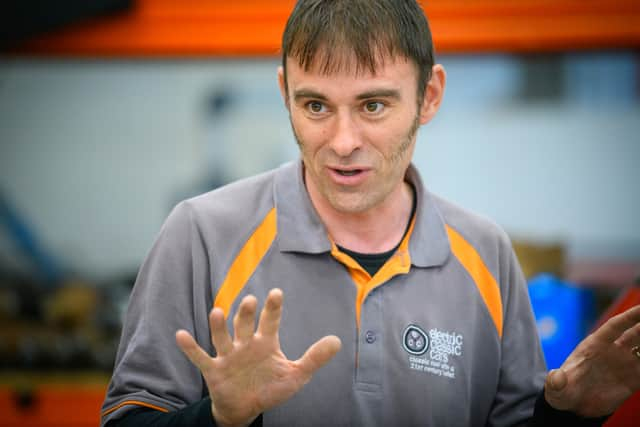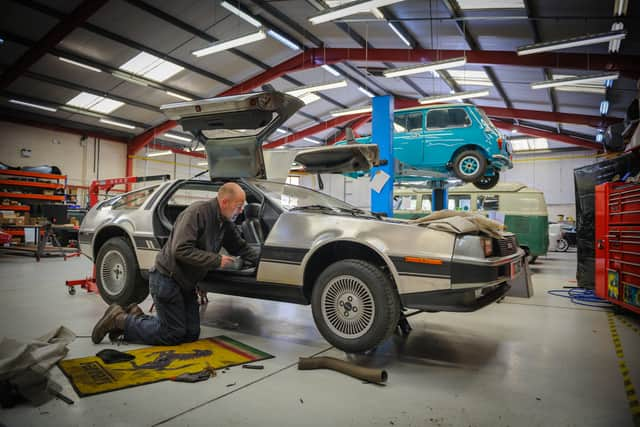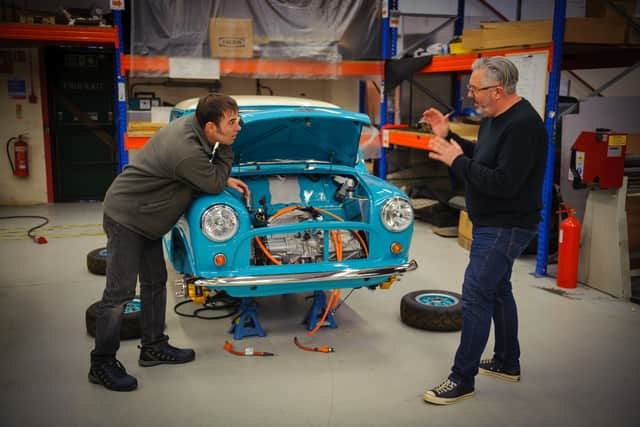Vintage Voltage: we meet the man giving old cars new life by converting them to EVs


Deep in the heart of Wales is a non-descript industrial unit where classic cars roll in to the sound of puttering flat-fours and snarling V8s and emerge accompanied by just the faint buzz of an electric motor as they head off into the hills.
The workshop is the base of Electric Classic Cars and the setting for the Quest documentary series Vintage Voltage, which sees a team of 21st century engineers turn fossil-fuel burning cars of the past into electrified vehicles of the future.
Advertisement
Hide AdAdvertisement
Hide AdAt the centre of both is ECC’s founder Richard “Moggy” Morgan, whose mission to breathe new life into his own classic has exploded into an all-consuming business converting everything from Beetles and bubble cars to Ferraris and Range Rovers.
With the second series of Vintage Voltage now airing every Thursday and interest in EVs at an all-time high, we caught up with Richard to find out what motivated him to start the business, why he’s convinced electrification is the future for many classic cars and hear his highlights and low points of the upcoming series.


Now occupying a 12,000 square foot workshop with 15 staff, six years ago ECC was based in a home garage with just three staff and a single car - Richard’s own.
“Having had classic cars from the age of 16, and having been a classic rally driver, I wanted to improve one of my cars so I could use it as a daily driver,” he explains.
Advertisement
Hide AdAdvertisement
Hide Ad“That meant making it extremely reliable, reducing the maintenance and increasing the power to be able to keep up with modern traffic. Converting it to electric seemed the obvious choice.”
It’s also the reason, Richard believes, that so many other people have come to him to convert their own vehicles in recent years, despite the undoubted expense of such a project.


On average a ECC conversion costs around £70,000, yet as the show’s popularity and Richard’s two-year waiting list show, there’s plenty of interest and demand for electrified classics.
So what is it that means owners of these often rare machines are willing to ditch their petrol-powered heart for an electric approach?
Advertisement
Hide AdAdvertisement
Hide AdFor a start, there’s a dependability that many old cars with temperamental motors can’t offer.
“A converted classic car always starts,” says Richard. “There’s less maintenance, less noise and zero pollution.
“As well as being more reliable you get better performance and a more enjoyable drive as a result.”
And Richard isn’t convinced by those who worry that electrifying a classic robs it of its character, pointing out that there is already a huge market for heavily updated restomods that do away with many original features.
Advertisement
Hide AdAdvertisement
Hide Ad“The naysayers may say it’s not a classic because it hasn’t got the smell of petrol or the noise but our clients tend to bring us cars where the engines are not special - for example, in the 911 we just converted the engine numbers didn’t match - or they may have a non-working engine. Often our customers’ projects will have an issue with the engine and there’s work required on the car.
“Doing restomods in classic cars is already a popular thing to do. Classic car owners are already swapping classic engines for resto engines for more power and performance. In some cases the original parts and engines are no longer available. Converting classics to electric can be a logical step to give these cars a new lease of life.
“We’re not trying to replace combustion-engined classics, we’re expanding the classic universe.”
Among the models given a new lease of life in this series of Vintage Voltage are everything from an original 190s Mini to a rare BMW “Batmobile” 3.0 CSi and a classic Series 2 Land Rover. Richard even breaks his own rule of avoiding more modern cars to complete a special project.
Advertisement
Hide AdAdvertisement
Hide Ad“One of my favourite cars in this series has been the DeLorean,” he says.
“I really enjoyed it because the base car was so poor. To get such a brilliant end result was a mega success and we managed to make the car worthy of what it needed to be.”


Turning the famous on-screen time machine into “the world’s coolest commuter car” for client Leighton involved plenty of work, not just to the drivetrain but to the chassis and interior of the tired 1980s sports car. But the hours of labour paid off and as well as restoring the car and replacing the DMC-12’s meagre 130bhp engine with a 300bhp Tesla-sourced motor to give it performance to match its looks, the team found time to fit a power function to the scene-stealing gullwing doors.
If the Tesla-powered Delorean was Richard’s highlight, the teeny tiny Mini, which now packs 10 times the power of the original petrol engine, caused some of the biggest headaches of the series.
Advertisement
Hide AdAdvertisement
Hide Ad“The Mini is a fine example of the difficulties we have trying out new battery technology,” he explains. “In this project we had to squeeze a 400V system into a small car. Similarly, we found the same challenges working with something so small when converting the Isetta. The challenges of getting that done meant that we looked at numerous different battery technologies before settling on one that worked.”
The high-performance Porsche 911 provided similar problems, requiring bespoke components to be made to support the rear-mounted motor and transfer its power to the wheels, as well as some millimetre-precise fitting to mount all the batteries and other components without ruining the car’s look or handling.


“It’s always a challenge getting new technology into old vehicles,” says Richard.
But the unique difficulties posed by every new project are a welcome challenge to Moggy’s team of engineers and balanced by the growing possibilities offered by EV technology.
Advertisement
Hide AdAdvertisement
Hide Ad“As battery tech advances we’ll take advantage of that and get better range in the vehicles. We are looking towards using new, more efficient motors and we’re speaking with battery manufacturers to get better suited options,” he says.
“The team is also taking advantage of faster charging so the cars’ charging times will be coming down. It’s exciting times ahead.”
On the immediate horizon for Richard and the team is another varied brace of classics waiting for the electric treatment.
“We’ve got some really brilliant projects coming up. We’re looking forward to working on the Jensen Interceptor and the Maserati Ghibli which is an iconic car but not necessarily well known to the general public.
Advertisement
Hide AdAdvertisement
Hide Ad“We’ve also got a more everyday British Triumph Vitesse on the waiting list, which will be interesting to do.”
And as for the model he’s yearning to get through the doors of his Newtown workshop? “I’d love to convert a Lamborghini Countach.”
With owners of all kinds of exotica lining up for the ECC team to work their magic, it’s surely only a matter of time before Richard gets his wish.
The new season of Vintage Voltage airs at 9pm on Thursdays on Quest and is available to stream on discovery+
